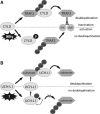PTMs in conversation: activity and function of deubiquitinating enzymes regulated via post-translational modifications
- PMID: 21480003
- PMCID: PMC3094536
- DOI: 10.1007/s12013-011-9176-6
PTMs in conversation: activity and function of deubiquitinating enzymes regulated via post-translational modifications
Abstract
Deubiquitinating enzymes (DUBs) constitute a diverse protein family and their impact on numerous biological and pathological processes has now been widely appreciated. Many DUB functions have to be tightly controlled within the cell, and this can be achieved in several ways, such as substrate-induced conformational changes, binding to adaptor proteins, proteolytic cleavage, and post-translational modifications (PTMs). This review is focused on the role of PTMs including monoubiquitination, sumoylation, acetylation, and phosphorylation as characterized and putative regulative factors of DUB function. Although this aspect of DUB functionality has not been yet thoroughly studied, PTMs represent a versatile and reversible method of controlling the role of DUBs in biological processes. In several cases PTMs might constitute a feedback mechanism insuring proper functioning of the ubiquitin proteasome system and other DUB-related pathways.
Figures

References
-
- Nijman SM, Luna-Vargas MP, Velds A, Brummelkamp TR, Dirac AM, Sixma TK, Bernards R. A genomic and functional inventory of deubiquitinating enzymes. Cell. 2005;123:773–786. - PubMed
-
- Wing SS. Deubiquitinating enzymes—the importance of driving in reverse along the ubiquitin-proteasome pathway. International Journal of Biochemistry and Cell Biology. 2003;35:590–605. - PubMed
-
- Piotrowski J, Beal R, Hoffman L, Wilkinson KD, Cohen RE, Pickart CM. Inhibition of the 26 S proteasome by polyubiquitin chains synthesized to have defined lengths. Journal of Biological Chemistry. 1997;272:23712–23721. - PubMed
-
- Raasi S, Varadan R, Fushman D, Pickart CM. Diverse polyubiquitin interaction properties of ubiquitin-associated domains. Nature Structural and Molecular Biology. 2005;12:708–714. - PubMed
-
- Wilkinson KD, Tashayev VL, O’Connor LB, Larsen CN, Kasperek E, Pickart CM. Metabolism of the polyubiquitin degradation signal: Structure, mechanism, and role of isopeptidase T. Biochemistry. 1995;34:14535–14546. - PubMed
Publication types
MeSH terms
Substances
Grants and funding
LinkOut - more resources
Full Text Sources
Miscellaneous

